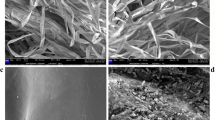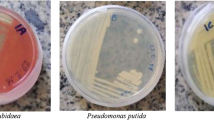Abstract
Background and aims
Nitrification is the first step in several pathways that lead to losses of nitrogen from agricultural systems. Biological nitrification inhibition (BNI) refers to the ability of some plant species to release chemicals from their roots that inhibit microbial ammonia oxidation thereby decreasing nitrification rates. BNI has been found in the wheat relative Leymus racemosus but not in Triticum aestivum. The aim of this work was to assess a number of landraces of Triticum aestivum for BNI ability.
Methods
Samples of root exudates and root tissue extracts, collected from hydroponically grown plants, were tested for their impact on nitrification rates when inoculated with pure cultures of two ammonia oxidising bacteria, Nitrosomonas europaea and Nitrosospira multiformis. Pot experiments were then conducted to confirm the results.
Results
The vast majority of the landraces tested caused some level of inhibition. However, of the 96 wheat landraces tested, 26 produced root exudates which caused a statistically significant reduction in nitrification rates of the two ammonia oxidising bacteria. Root exudates from four of the BNI positive landraces were shown to significantly inhibit nitrification rates in a sandy loam soil.
Conclusions
This is the first evidence of significant levels of BNI in Triticum aestivum. The discovery of landraces with BNI ability raises the potential for breeding this trait into modern, elite wheat cultivars.


Similar content being viewed by others

References
Amberger A (1989) Research on dicyandiamide as a nitrification inhibitor and future outlook. Communications in Soil Science and Plant Analysis 20:1933–1955
Arp DJ, Stein LY (2003) Metabolism of inorganic N compounds by ammonia-oxidizing bacteria. Critical Reviews in Biochemistry and Molecular Biology 38:471–495
Chen PD, Liu WX, Yuan JH, Wang X, Zhou B, Wang SL, Zhang SZ, Feng YG, Yang BJ, Liu GX, Liu DJ, Qi LL, Zhang P, Friebe B, Gill BS (2005) Development and characterization of wheat- Leymus racemosus translocation lines with resistance to fusarium head blight. Theoretical and Applied Genetics 111:941–948
Chen DL, Suter HC, Islam A, Edis R (2010) Influence of nitrification inhibitors on nitrification and nitrous oxide (N2O) emission from a clay loam soil fertilized with urea. Soil Biology & Biochemistry 42:660–664
Chen QH, Qi LY, Bi QF, Dai PB, Sun DS, Sun CL, Liu WJ, Lu LL, Ni WZ, Lin XY (2015) Comparative effects of 3,4-dimethylpyrazole phosphate (DMPP) and dicyandiamide (DCD) on ammonia-oxidizing bacteria and archaea in a vegetable soil. Applied Microbiology and Biotechnology 99:477–487
Di HJ, Cameron KC, Shen JP, He JZ, Winefield CS (2009a) A lysimeter study of nitrate leaching from grazed grassland as affected by a nitrification inhibitor, dicyandiamide, and relationships with ammonia oxidizing bacteria and archaea. Soil Use and Management 25:454–461
Di HJ, Cameron KC, Shen JP, Winefield CS, O’Callaghan M, Bowatte S, He JZ (2009b) Nitrification driven by bacteria and not archaea in nitrogen-rich grassland soils. Nature Geoscience 2:621–624
Di HJ, Cameron KC, Sherlock RR, Shen JP, He JZ, Winefield CS (2010) Nitrous oxide emissions from grazed grassland as affected by a nitrification inhibitor, dicyandiamide, and relationships with ammonia-oxidizing bacteria and archaea. Journal of Soils and Sediments 10:943–954
Erguder TH, Boon N, Wittebolle L, Marzorati M, Verstraete W (2009) Environmental factors shaping the ecological niches of ammonia-oxidizing archaea. Fems Microbiology Reviews 33:855–869
Fillery IRP (1999) Monitoring water and nutrient fluxes down the profile: closing the nutrient budget. In: Rengel Z (ed) Mineral nutrition of crops: fundamental mechanisms and implications. Food Products Press, Binghamton, pp 289–325
Fillery IRP (2007) Plant-based manipulation of nitrification in soil: a new approach to managing N loss? Plant and Soil 294:1–4
Focht DD, Verstraete W (1977) Biochemical ecology of nitrification and denitrification. Advances in Microbial Ecology 1:134–214
Gopalakrishnan S, Subbarao GV, Nakahara K, Yoshihashi T, Ito O, Maeda I, Ono H, Yoshida M (2007) Nitrification inhibitors from the root tissues of Brachiaria humidicola, a tropical grass. Journal of Agricultural and Food Chemistry 55:1385–1388
Hu H-W, Xu Z-H, He J-Z (2014) Ammonia-oxidizing archaea play a predominant role in acid soil nitrification. In: DL Sparks (ed) Advances in Agronomy, Vol 125
Ishikawa T, Subbarao GV, Ito O, Okada K (2003) Suppression of nitrification and nitrous oxide emission by the tropical grass Brachiaria humidicola. Plant and Soil 255:413–419
Jia ZJ, Conrad R (2009) Bacteria rather than archaea dominate microbial ammonia oxidation in an agricultural soil. Environmental Microbiology 11:1658–1671
Lata JC, Degrange V, Raynaud X, Maron PA, Lensi R, Abbadie L (2004) Grass populations control nitrification in savanna soils. Functional Ecology 18:605–611
Leininger S, Urich T, Schloter M, Schwark L, Qi J, Nicol GW, Prosser JI, Schuster SC, Schleper C (2006) Archaea predominate among ammonia-oxidizing prokaryotes in soils. Nature 442:806–809
Liu R, Hayden H, Suter H, He JZ, Chen DL (2015) The effect of nitrification inhibitors in reducing nitrification and the ammonia oxidizer population in three contrasting soils. Journal of Soils and Sediments 15:1113–1118
McCarty GW (1999) Modes of action of nitrification inhibitors. Biology and Fertility of Soils 29:1–9
Moreta DE, Arango J, Sotelo M, Vergara D, Rincon A, Ishitani M, Castro A, Miles J, Peters M, Tohme J, Subbarao GV, Rao IM (2014) Biological nitrification inhibition (BNI) in Brachiaria pastures: a novel strategy to improve eco-efficiency of crop-livestock systems and to mitigate climate change. Tropical Grasslands - Forrajes Tropicales. Centro Internacional de Agricultura Tropical (CIAT), Cali
Norton JM, Stark JM (2011) Regulation and measurement of nitrification in terrestrial systems. In: Klotz MG (ed) Methods in Enzymology: Research on Nitrification and Related Processes, Vol 486, Part A. Elsevier Academic Press Inc, San Diego, pp 343–368
O’Sullivan CA, Wakelin SA, Fillery IRP, Roper MM (2013) Factors affecting ammonia-oxidising microorganisms and potential nitrification rates in southern Australian agricultural soils. Soil Research 51:240–252
Parkin TB, Hatfield JL (2010) Influence of nitrapyrin on N2O losses from soil receiving fall-applied anhydrous ammonia. Agriculture Ecosystems & Environment 136:81–86
Prosser JI, Nicol GW (2012) Archaeal and bacterial ammonia-oxidisers in soil: the quest for niche specialisation and differentiation. Trends in Microbiology 20:523–531
Raun WR, Johnson GV (1999) Improving nitrogen use efficiency for cereal production. Agronomy Journal 91:357–363
Rossiter-Rachor NA, Setterfield SA, Douglas MM, Hutley LB, Cook GD, Schmidt S (2009) Invasive Andropogon gayanus (gamba grass) is an ecosystem transformer of nitrogen relations in Australian savanna. Ecological Applications 19:1546–1560
Saari A, Martikainen PJ (2001) Differential inhibition of methane oxidation and nitrification in forest soils by dimethyl sulfoxide (DMSO). Soil Biology & Biochemistry 33:1567–1570
Schleper C, Nicol GW (2010) Ammonia-Oxidising Archaea - Physiology, ecology and evolution. In: Advances in Microbial Physiology, Vol 57. Academic Press Ltd-Elsevier Science Ltd, London, pp 1–41
Shen JP, Zhang LM, Zhu YG, Zhang JB, He JZ (2008) Abundance and composition of ammonia-oxidizing bacteria and ammonia-oxidizing archaea communities of an alkaline sandy loam. Environmental Microbiology 10:1601–1611
Subbarao GV, Ishikawa T, Ito O, Nakahara K, Wang HY, Berry WL (2006) A biolumiuescence assay to detect nitrification inhibitors released from plant roots: a case study with Brachiaria humidicola. Plant and Soil 288:101–112
Subbarao GV, Rondon M, Ito O, Ishikawa T, Rao IM, Nakahara K, Lascano C, Berry WL (2007a) Biological nitrification inhibition (BNI) - is it a widespread phenomenon? Plant and Soil 294:5–18
Subbarao GV, Tomohiro B, Masahiro K, Osamu I, Samejima H, Wang HY, Pearse SJ, Gopalakrishnan S, Nakahara K, Hossain A, Tsujimoto H, Berry WL (2007b) Can biological nitrification inhibition (BNI) genes from perennial Leymus racemosus (Triticeae) combat nitrification in wheat farming? Plant and Soil 299:55–64
Subbarao GV, Wang HY, Ito O, Nakahara K, Berry WL (2007c) NH4 + triggers the synthesis and release of biological nitrification inhibition compounds in Brachiaria humidicola roots. Plant and Soil 290:245–257
Subbarao GV, Nakahara K, Ishikawa T, Yoshihashi T, Ito O, Ono H, Ohnishi-Kameyama M, Yoshida M, Kawano N, Berry WL (2008) Free fatty acids from the pasture grass Brachiaria humidicola and one of their methyl esters as inhibitors of nitrification. Plant and Soil 313:89–99
Subbarao GV, Nakahara K, Hurtado MP, Ono H, Moreta DE, Salcedo AF, Yoshihashi AT, Ishikawa T, Ishitani M, Ohnishi-Kameyama M, Yoshida M, Rondon M, Rao IM, Lascano CE, Berry WL, Ito O (2009) Evidence for biological nitrification inhibition in Brachiaria pastures. Proceedings of the National Academy of Sciences of the United States of America 106:17302–17307
Suzuki I, Kwok SC, Dular U (1976) Competitive inhibition of ammonia oxidation in Nitrosomonas europaea by methane, carbon monoxide or methanol. Febs Letters 72:117–120
Swezey AW, Turner GO (1962) Crop experiments on effect of 2-chloro-6-(trichloromethyl)pyridine for control of nitrification of ammonium and urea fertilizers. Agronomy Journal 54:532–534
Tanaka JP, Nardi P, Wissuwa M (2010) Nitification inhibition activity, a novel trait in root exudates of rice. Ann Bot Plants 2010:plq014
Weaver RW, Angle JS, Bottomley BS, Hart SC, Stark JM, Davidson EA, Firestone MK (1994) Nitrogen mineralization, immobilization, and nitrification. In: Methods of Soil Analysis. Part 2. Microbiological and Biochemical Properties, SSSA Book Series. SSSA, Madison
White CS (1986) Volatile and water soluble inhibitors of nitrogen mineralisation and nitrification in a Poderosa pine ecosystem. Biology and Fertility of Soils 2:97–104
White CS (1988) Nitrification inhibition by monoterpenoids: theoretical mode of action based on molecular structures. Ecology 69:1631–1633
White CS (1991) The role of monoterpenes in soil nitrogen cycling processes in Ponderosa pine: results from laboratory bioassays and field studies. Biogeochemistry 12:43–68
Zakir H, Subbarao GV, Pearse SJ, Gopalakrishnan S, Ito O, Ishikawa T, Kawano N, Nakahara K, Yoshihashi T, Ono H, Yoshida M (2008) Detection, isolation and characterization of a root-exuded compound, methyl 3-(4-hydroxyphenyl) propionate, responsible for biological nitrification inhibition by sorghum (Sorghum bicolor). New Phytologist 180:442–451
Zerulla W, Barth T, Dressel J, Erhardt K, von Locquenghien KH, Pasda G, Radle M, Wissemeier AH (2001) 3,4-Dimethylpyrazole phosphate (DMPP) - a new nitrification inhibitor for agriculture and horticulture - An introduction. Biology and Fertility of Soils 34:79–84
Zou HY, Zhang WT, Feng YY, Liang B (2014) Simultaneous determination of melamine and dicyandiamide in milk by UV spectroscopy coupled with chemometrics. Analytical Methods 6(15):5865–5871
Acknowledgements
This work was funded by Bayer CropScience. The authors would like to thank Mrs Karen Treble for the technical assistance that she provided to support these experiments and the staff from the Australian Winter Cereals Collection for making available the seeds of the wheat landraces. We also thank the staff from The Department of Agriculture and Food, Western Australia for allowing access to the Vasse Research Station for soil sampling.
Author information
Authors and Affiliations
Corresponding author
Additional information
Responsible Editor: Elizabeth M Baggs.
Electronic supplementary material
Below is the link to the electronic supplementary material.
ESM 1
(DOCX 247 kb)
Rights and permissions
About this article
Cite this article
O’Sullivan, C.A., Fillery, I.R.P., Roper, M.M. et al. Identification of several wheat landraces with biological nitrification inhibition capacity. Plant Soil 404, 61–74 (2016). https://doi.org/10.1007/s11104-016-2822-4
Received:
Accepted:
Published:
Issue Date:
DOI: https://doi.org/10.1007/s11104-016-2822-4



